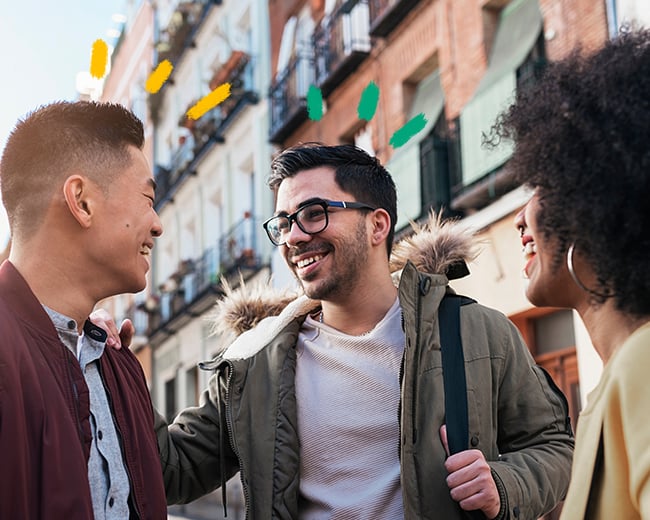The feeling of using a new language to interact with real people is an INCREDIBLE feeling. One of life’s best. To experience it? You need to know how to start conversations in Korean.
Listen carefully: because there are levels of formality to Korean speech. Ranging from casual – polite/standard – formal. Korean locals are super forgiving to any foreigners on this.
But to be extra safe and avoid any potential discontent – pay attention to the polite versions of words and phrases when you start learning Korean.
Before declaring any Korean greeting (인사: insa) – take a minute to sum up the situation and decide.
For reference: these 3 factors influence what formality level of speech you should use.
- How well you know the person.
- Their social status (Teacher? Boss?)
- Their age.
Oh, and no shouting or aggressive physical contact (hugs, kisses, back pats, etc). Okay? You’ve got this!

How to say hello and greet in different situations
First thing’s first. A slight bow is a great way to say hello in South Korea.
The greeting bow:
How to say hello in business:
In addition to a bow, colleagues usually shake hands with each other using two hands to show respect.
The Korean Wave (한류) refers the global obsession with South Korea’s popular culture. More than this: the food, technology, business, geography, and people are attracting huge numbers to learn Korean.
The point is: learning Korean is seriously cool. And to be able to show off your awesome Korean language skills, you’ll need to start conversations the right way! Heads up. Before learning any others: we recommend you focus on the ‘polite’ versions of these sayings.
Here’s how to say hello in Korean in different situations:
How to say Hello in Korean
안녕하세요 (Annyeonghaseyo) = hello (polite, safe version)
Get this one memorised. It’s the most used way of saying hello!
안녕하십니까 (annyeonghasimnikka) = hello (formal)
You may see it on the news in Korea; and it’s used to greet someone unfamiliar, or of high social standing or age for the first time.
Hello (on the telephone) = 여보세요 (yeoboseyo)
Only use this on the telephone! Saying it in real life will only cause confusion.
How to say hi in Korean:
An intimate greeting for close friends! Only spoken to people the same age or younger than you. Note: This is mainly for a younger generation (locals over 40 would rarely use 안녕).
Fun ways how to say hey in Korean:
야 (Ya!) = hey! (casual)
잘 지냈어? (Jal jinaesseo?) = what’s up (casual)
오랜만이에요 (Oraenmanieyo) = long time no see (casual, polite)
Top 5 Korean conversation flowers
When speaking in another language… sometimes you need to bide your time. Enjoy a moment to digest the conversation or think of a great word or phrase! Which is why a short conversation filler can be perfect for keeping the conversation going.
Get excited about connecting with Koreans! Here are some of our favourites:
- 진짜요? = Really? Seriously?
- - 그래요? = Is that so?
- 그렇군요 = I see/I understand
- 맞아요 = Right/I agree with you/That's true.
- 좋겠어요 = That must be nice!
Okay. You’re smashing this. Sparking up great conversations in Korean using useful words and phrases as you go. Congratulations!
Now it’s time for a few more essentials…
How to say welcome in Korean:
어서 오세요 eoseo oseyo = welcome (polite)
Use this to mean ‘please come in’ with people older than you, people you don’t know too well, and people who have higher status than you (e.g. your boss).
환영합니다 (hwanyeonghamnida) = welcome (formal)
Seen on hotel reception desks, banners, or business cards.
어서 와 (eoseo wa) = welcome (informal)
Use this with close friends and people younger than you.
How to say 'how are you?' in Korean:
잘 지냈어요? (jal jinaesseoyo) = how are you? (polite)
잘 지냈어? (jal jinaesseo) = how are you? (casual, close friends)
Some variations:
잘 있었어요? (jal isseosseoyo) = translates to ‘have you been well?’ (polite)
네. 잘 지냈어요? (Ne. Jal jinaesseoyo?) = I’m good/well. How are you?
밥 먹었어요? (bap meogeosseoyo) = have you eaten?
That’s right… Korean locals like to check if the person they are speaking to has eaten! Korean food is a huge part of the social culture.
Why not grab some chimaek 치맥 (fried chicken and beer) with your new friend?

How to say nice to meet you in Korean:
만나서 반가워요 (mannaseo bangawoyo) = nice to meet you (polite)
만나서 반갑습니다 (mannaseo bangapseumnida) = nice to meet you (formal)
만나서 반가워 (mannaseo bangawo) = nice to meet you (casual)
How to say good morning in Korean:
좋은 아침이에요 (joeun achimieyo) = (it is a) good morning
How to say good afternoon + how to say good evening in Korean:
Interestingly, the standard/polite word for hello: 안녕하세요 (annyeong haseyo) can be used to mean good afternoon or good evening. Add a slight bow to be polite or express thanks, for example after leaving a meal.
How to say goodbye in Korean:

Listen up. Here’s how to say bye in Korean in two different circumstances.
안녕히 계세요 (annyeonghi gyeseyo) = saying to someone who is staying
안녕히 가세요 (annyeonghi gaseyo) = saying to someone who is leaving
How to say 'have a nice day' in Korean
좋은 하루 되세요 (joeun haru doeseyo) = have a nice day! (polite)
좋은 하루 보내십시오 (joeun haru bonaesipsio) = have a nice day! (formal)
좋은 하루 보내 (joeun haru bonae) = have a nice day! (casual)
잘 가 (jal ga) = bye! (casual)
How to say goodnight in Korean:
안녕히 주무세요 (annyeonghi jumuseyo) = goodnight/sleep well (polite)
잘 자요 (jal jayo) = goodnight (standard/polite)
잘 자 (jal ja) = goodnight (casual)
This blog may be over. But your journey to speaking Korean has only just begun...
You now know how to say hello and goodbye in Korean, and more speaking essentials. Learn what you’ll use to understand and communicate with REAL Korean locals via our app. You know what to do…









